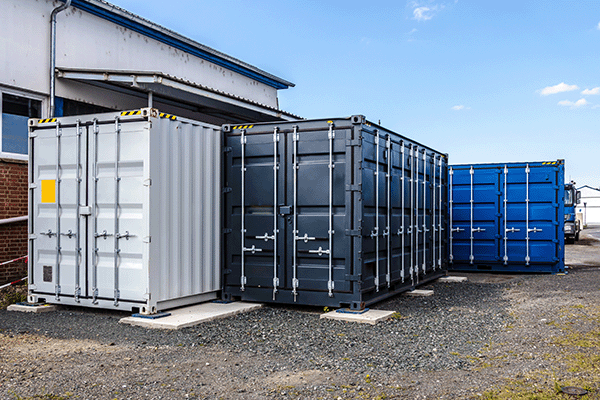Partner with Downstream

When it comes to protecting tools, equipment, and materials on a construction site, storage containers are one of the most practical and secure solutions available. Whether you’re managing a fast-paced tenant improvement project or a long-term commercial build, having on-site storage that’s durable, accessible, and weather-resistant is essential. In this guide, we’ll walk through key considerations when renting or purchasing a storage container for your jobsite, how to size and configure them for your needs, and why choosing the right partner for delivery and removal matters.

Storage containers have become the go-to for jobsite storage because they offer:
These benefits make them ideal for storing power tools, electrical components, HVAC parts, drywall, paint, PPE, and more.

Most containers come in standardized lengths, typically:
Some containers come with doors on both ends, which increases accessibility and reduces the time spent moving material in and out.
Basic padlocks aren’t enough. Many jobsites now require containers with welded lock boxes that shield the locking mechanism from bolt cutters or tampering.
To avoid condensation build-up—especially in humid climates or if storing chemicals—choose containers with built-in vents.
Pre-installed shelving or modular racks help keep smaller items organized and off the floor, improving inventory management on busy jobsites.
Standard containers are ground-level by default, but make sure they’re placed on stable surfaces (e.g., wood blocks or gravel pads) to prevent flooding or shifting.
Different projects require different container setups. Here’s how they break down:
For more insights on adapting container storage to complex sites, Construction Executive discusses strategies for securing jobsites with limited access points or heavy foot traffic.
Before a container arrives, coordinate with building management or general contractors to avoid headaches. Consider:
If your project lasts less than a year or involves multiple phases, renting is typically more cost-effective. For long-term or multi-site contractors, buying can make sense if the container will be reused.
Renting Pros:
Buying Pros:
Whether you need a 10-foot unit delivered to a tight downtown alley or a 40-foot container with shelving for a major build, Downstream makes it simple to source and schedule the right storage container for your project.
With multiple vendors in every major market, we help you compare rates, schedule deliveries, and lock in the best deal—without spending hours calling around. Plus, we offer add-ons like shelving, lock boxes, ramps, and even climate control depending on your jobsite needs.
Check pricing and availability now on Downstream
Storage containers are more than just metal boxes—they’re a vital piece of jobsite logistics that protect your investment, reduce shrinkage, and help crews stay productive. Choosing the right size, features, and placement strategy ensures your storage setup works as hard as your team does.
Need help navigating your next container rental? Tap into Downstream’s marketplace to get it done right the first time.
-min.webp)
Quis nostrud exercitation ullamco laboris nisi ut aliquip ex ea commodo consequat. Duis aute irure dolor in voluptate.
